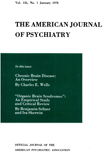JAPANESE PSYCHIATRY AND PSYCHOTHERAPY
Abstract
An attempt is made to give some of the philosophy and methods that underlie present-day Japanese psychiatry. A brief discussion of psychosis is given. The classification of "shinkeishitsu" with its subgroupings of neurasthenic states, obsessive-phobic states, and paroxysmal neurosis is outlined and discussed. Monita's 4-phase therapy for treating "shinkeishitsu" is presented together with statistics compiled by the Kyushu University Medical School department of neuropsychiatry. Cultural factors such as Buddhistic influences, national traditions, and cultural patterns are elaborated where they relate to the classification and treatment of mental diseases in Japan. Symptoms characteristic of "shinkeishitsu" are listed with their frequency of occurrence as they were observed at the Kyushu Medical School Clinic. An attempt is made to explain these symptoms on the basis of cultural and historical factors. Some of the limitations of the Japanese approach to psychotherapy as exemplified by Monita's treatment of "shinkeishitsu" are discussed.
Access content
To read the fulltext, please use one of the options below to sign in or purchase access.- Personal login
- Institutional Login
- Sign in via OpenAthens
- Register for access
-
Please login/register if you wish to pair your device and check access availability.
Not a subscriber?
PsychiatryOnline subscription options offer access to the DSM-5 library, books, journals, CME, and patient resources. This all-in-one virtual library provides psychiatrists and mental health professionals with key resources for diagnosis, treatment, research, and professional development.
Need more help? PsychiatryOnline Customer Service may be reached by emailing [email protected] or by calling 800-368-5777 (in the U.S.) or 703-907-7322 (outside the U.S.).



